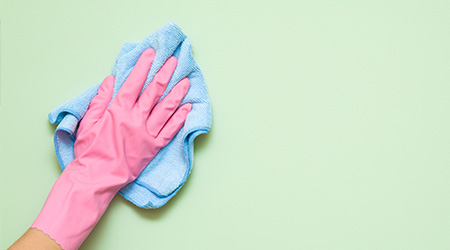
We have determined how much time is required to wash the walls and considered how to workload the tasks to maximize effectiveness. Now let's take a moment to review one of many possible ways of washing the walls in question. Since you have painted concrete walls and other surfaces, we will begin with simple painted concrete that does not require as much preparation. We will be doing the tasks in hallways that will not require much set up/take down or protection so long as floor finishes, carpet, etc. are not impacted. You can use this exercise to determine the best steps for washing the other types of walls in your inventory.
1. Determine what the surface is made of. In our example we are going to wash a concrete wall that has washable paint on it. Note that "flat" finished water based paint may not be washable without some damage. Always test first. The walls are approximately twelve years old and have a combination of oily grime above five feet with heel marks, scratches, etc. from the base to five feet.
2. Determine the best cleaning solution which will probably be a mild, neutral detergent.
3. Select the correct tool which will probably be a microfiber flat mop head on a T-bar swivel handle that has been dipped in solution. Plan on having several heads since they will become soiled and will need to be laundered.
4. Use either a spray bottle (small areas) or a quart sprayer to wet the walls from bottom to top one section at a time. Note that you may need to have drop cloths, plastic or other covers for the floor and any furniture that cannot be moved.
5. Use the dampened flat mop on the T-bar handle to wipe the walls from top to bottom using care to cover/overlap each area.
6. You may need to use a micro sponge for the heel marks and other soils. Test other cleaners for the most effective removal without damaging paint or leaving scrub spots.
7. You may need to rinse and even dry the walls being careful to remove streaks.
The results should be a cleaner wall with a minimum of scrub spots. There may be some stains/marks that cannot be removed. Once you have done a test area, back off and decide whether it is time to repaint.
Your comments and questions are important. I hope to hear from you soon. Until then, keep it clean...
Mickey Crowe has been involved in the industry for over 35 years. He is a trainer, speaker and consultant. You can reach Mickey at 678-314-2171 or CTCG50@comcast.net.
posted on 1/31/2018

 The Down and Dirty on Cleaning in Virus Season
The Down and Dirty on Cleaning in Virus Season How Surfactant Use is Expanding in Commercial Cleaning
How Surfactant Use is Expanding in Commercial Cleaning